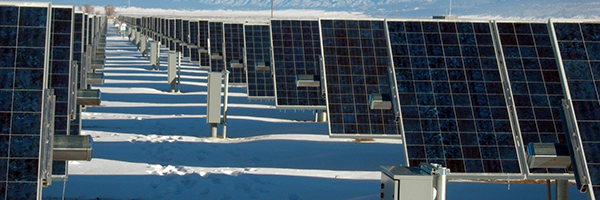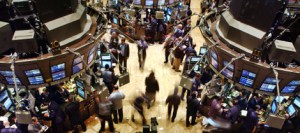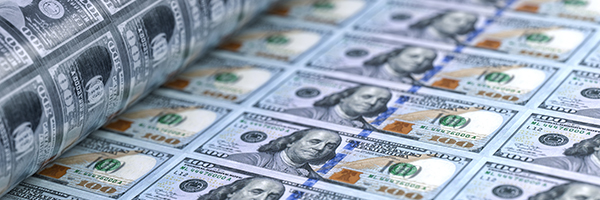 April 26, 2025
April 26, 2025
What You Need to Know Today:
It’s not the R word that has stocks plunging–it’s that S word
We haven’t had a really severe bout of stagflation since the late 1970s and early 1980s–but suddenly that scenario of very slow growth with high unemployment but with high inflation too that prevents the Federal Reserve from just cutting interest rates get growth back on track is back on Wall Street’s worry list.
And really serious stagflation would be something to worry about. In 1980–just before the Federal Reserve created a deep recession and bear market to break the back of stagflation–inflation hit almost 14.5 and unemployment reached 7.5%
Two sells before the tariffs start–more to come, I suspect
Stocks moved down slightly on Friday–with the Standard & Poor’s 500 off 0.50% and the NASDAQ Composite down 0.28%–as investors started to revise their belief that President Donald Trump wasn’t really serious about raising tariffs.
Now that the White House as made it clear that the first round of tariffs–on Canada, Mexico, and China–will go into effect on Tuesday, I think we’ll see more downward movement in stocks. I don’t expect the drop to be swift or especially severe to start. That will have to wait until the economy starts to register the effects of higher prices for so much that we import. But I’d like to get ahead of this revision in sentiment with some sells now.

Trump tariffs target Tuesday–Canada, Mexico and China plan retaliation
Effective Tuesday at 12:01 a.m. Eastern time, American importers will pay a new 25% tax on goods from Canada and Mexico and a 10% tariff on products from China, President Donald Trump said on Saturday.

No good new for Fed interest rate cuts in today’s inflation data
Today’s release of the PCE (Personal Consumption Expenditure) index, the Federal Reserve’s preferred inflation measure, wasn’t good news for investors hoping that the central bank will quickly resume interest rate cuts. The PCE climbed 2.6% in December from a year earlier, faster than its 2.4% annual rate in November and above the central bank’s 2 percent target. Compared to the previous month, prices were up 0.3%.

First Trump tariffs due tomorrow?
The great tariffs guessing game looks like it will end tomorrow. At least Round One. Today White House press secretary Karoline Levitt said reports that tariffs wouldn’t be imposed until of tariffs from 1 March. She then said that President Donald Trump plans to impose his first round of tariffs tomorrow, February 1.

GDP growth slows a bit in the fourth quarter–but what does it mean?
The U.S. economy grew at a solid rate in the fourth quarter but growth still slowed in the last three months of the year. Data this morning from the Bureau of Economic Analysis showed that the economy expanded at an annual rate of 2.3% in the fourth quarter, down from annualized growth of about 3% in the two previous quarters. The fourth quarter results mean that for all of 2024 the economy grew bt 2.8% The details of forth quarter growth were quite a puzzle, though.

Special Report: 10 Penny Stock Home Runs–Pick #3 GWH
Special Report: 10 Penny Stock Home Runs Pick #3 ESS Tech (GWH). The stock of this maker of iron flow, utility scale, long-draw-down batteries ticks all the boxes for my Penny Stock Home Runs.
Live Market Report (20 minute delay)

Special Report: 10 Great Growth Stocks that Are Getting Greater–today my 8th pick BYD
GREATER Growth Stock Pick #8: BYD (BYDDF). I know; I know. What’s a Chinese stock doing on this list? It’s here because BYD, not Tesla (TSLA) is the big growth story in electric vehicles and not just for this month–but for years. And because I can see two catalysts that are about to power this stock higher. Morningstar calculates that BYD is 20% undervalued right now. Because this is a China stock we’ll need to take a deep look at valuation later in this post. But first, the growth story.

What to make of Cummins’ $2 billion penalty for Clean Air Act cheating
Here’s what an investor should watch after Cummins’ huge $2 billion Clean Air Act settlement.

Saturday Night Santa Claus says (on a Tuesday), For the week ahead expect…
Stocks continued on an upward path in a classic Santa Claus rally. Wall Street kicked off the final week of 2023 with gains in stocks, extending a rally that put the market on the brink of a record. Today, December 26, the Standard & Poor’s 500 traded about 0.5% away from its all-time high of 4,796.56. The so-called Santa Claus rally, which typically encompasses the last five trading sessions of the year and the first two of the new one, has a strong record of gains. Since 1969, the S&P 500 has averaged a gain of 1.3% over the seven-day period, according to the Stock Trader’s Almanac.

Don’t forget year-end tax loss harvesting–it could be extra valuable this year
You have until December 31–which effectively means Friday December 29 (although I wouldn’t push the deadline, personally) to sell your losers this year to off set any gains from winners you sold during the year. Given the way the year has unfolded, harvesting your tax losses to offset gains could be especially valuable this year.

Merry Christmas to all
I wish you all a Merry Christmas. Or a Happy Holiday of your choice. Hope Santa brings you everything you wished for. (And that you don’t get two more reindeer sweaters.) Looking forward to a more peaceful new year. One can always hope.

Is the good news priced in for Micron?
Right now memory chip maker Micro Technology (MU) is a microcosm of the stock market as a whole. There’s good news–pretty clearly–on the horizon. But the worry is that it’s already mostly priced into the stock. This week Micron, the largest U.S. maker of memory chips, gave a forecast for the fiscal second quarter that sure made it sound like the company, and the memory chip sector in general, was about to turn the corner after getting hammered on slumping demand for chips for personal computers and smartphones.

Bonds keep chugging higher, stock investors have doubts
Bond traders and investors kept the bond rally going today December 20. The yield on the 10-year Treasury dropped another 8 basis points to 3.85% today. The yield on the 2-year note fell 4 basis points to 4.40%. The drop in yields came as a result of gains in bond prices. On the other hand, the major stock indexes had a big down day. The Standard & Poor’s 500 fell 1.47% and the Dow Jones Industrial Average ended the day down 1.27%. The small-cap Russell 2000 dropped 1.86%. The NASDAQ Composite and the NASDAQ 100 soared 1.50% and 1.53%, respectively.. The differing results don’t reflect a divergence of views on interest rates–both bond and stock markets see the Federal Reserve cutting interest rates in 2024. The difference does, however, reflect differing views on valuation

U.S. oil production hits a record, destroying OPEC’s supply cut strategy
The world’s No. 2 oil producer, Saudi Arabia, wants to cut oil production to raise oil prices. And has even actually curtailed production to meet that goal. The world’s No 3 oil producer, Russia, wants (others mostly) to cut oil production to raise prices. And has even promised to cut its own production. (We’ll believe that when we see it.) But none of that matters because the world’s No. 1 oil producer, the United States, has put its foot to the accelerator and is producing at record volumes.

S&P 500 earnings on track to grow by just 0.6% in 2023
FactSet calculates that Wall Street analysts expect the S&P 500 to report earnings growth of 0.6% in calendar 2023. That’s way below the trailing 10-year average (annual) earnings growth rate of 8.4% for 2021 through 2022. So far on a quarterly basis, 2023 has shaped up this way: earnings declines of 1.7% and 4.1% for the S&P 500 in the first nd second quarters of 2023, respectively. And earnings growth of 4.9% for the third quarter. FactSet calculates that analysts expect the stocks in the index to report an earnings growth of 2.4% for Q4 2023.

Apple hit with patent judgment that puts quarterly sales growth in question
The hope among investors and on Wall Street was that Apple (AAPL) would show revenue growth when it reported its fiscal first quarter earnings in January. That growth would be the first in a year after four straight quarters of falling sales. That’s the longest streak of declining quarterly sales in two decades. But now a patent decision against Apple will take some of its best-selling Apple Watch series, the Series 9 and the Ultra2, off the market just as the holiday selling season is peaking.

Saturday Night Quarterback says, For the week ahead expect…
I expect the Federal Reserve to continue to try talking back some of the enthusiasm that greeted its December 13 meeting and the release of a new set of Dot Plot projections showing that the median forecast of staff and policy makers at the U.S. central bank called for three interest rate cuts in 2024.

Finally–Costco declares special $15 a share dividend; is membership increase next?
Costco Wholesale (COST) reported earnings for its fiscal first quarter of 2024 and declared a long anticipated special dividend of $15 a share. The stock closed up 4.61% on Friday, December 15.

Is the Fed “sorry” that it set off the latest rally?
Today sure sounded like policy-makers remorse from the Federal Reserve. New York Fed President, the vice-chair of the Federal Reserve’s interest-rate setting Open Market Committee, said that central-bank policy makers weren’t actively debating when to cut interest rates. That’s sure not what the stock market heard on Wednesday.

How many interest rate cuts will we see in 2024?
In its December revision of its Dot Plot projections for interest rates in 2024, the median projection by the U.S. central bank’s staff and policy makers estimated three interest rate cuts by the end of 2024. The market, which had been hoping for exactly this news, cheered, and stocks moved to record or near record highs. And in reaction to the Fed’s news, Wall Street moved its forecasts to match the new projection. Barclays, for example, is calling for three cuts in 2024 and JPMorgan Chase moved its forecast for the start of cuts to June. But, on Wall Street nothing exceeds like excess so projections are pushing beyond the Fed’s median view.

Troubles aren’t over for electric vehicle sales–will EV stocks feel the pain?
Electric vehicle inventories on lots at U.S. dealers reached a new high in December. With a 114-day supply, the bloated inventory of electric vehicles is up from a 53-day supply a year ago and compares to 71-days worth of inventory for the overall auto industry.

Solar stocks rocket higher on Day 2 of the post-Fed meeting rally
Among today’s big stock market winners today: SolarEdge Technologies (SEDG), the biggest maker of inverters used in turning sunlight into electricity, closed up 16.67%, and Sunrun (RUN), a leader in the installation of residential solar systems, closed up 19.92%. This rally had absolutely nothing to do with any news out of the recently ended COP28 United Nations Climate Conference. It was a pure reaction to the signs in yesterday’s Dot Plot from the Federal Reserve that the central bank was looking to cut interest rates at least three times in 2024. Makes perfect sense.

Moderna shares jump today on positive results in skin cancer vaccine trials
Shares of Moderna (MRNA) closed up 925% today, December 14. A personalized vaccine developed by Merck and Moderna helped prevent the recurrence of severe skin cancer for three years, according to new results released today. Patients with severe melanomas who got the vaccine and Merck’s cancer drug Keytruda were 49% less likely to die or have their cancer return than those who got Keytruda alone. The news is especially important for Moderna.

The Fed catches up with the markets on interest rate cuts and stocks soar
Today, the Federal Reserve caught up with the financial markets. The Fed’s Open Market Committee kept interest rates steady at a benchmark 5.25% to 5.50%, as expected. And the Fed’s Dot Plot projections showed that the median projection expects three interest rate cuts in 2024. That’s a huge shift from the September Dot Plot and moves the Fed toward the current Wall Street hope for 4 cuts or more in 2024. The Dot Plot also projects that the unemployment rate would rise slightly next year, to 4.1%, from a recent 3.7% rate, and that inflation would continue to improve in 2024 but not reach the Fed’s 2% target. Stocks soared on the confirmation of the consensus hope. At the close, the Dow Jones Industrial Average jumped 512.3 points, or 1.4%, to a record high of 37,090.24. The S&P 500 index climbed 1.37%, and the Nasdaq 1.38%.

Special Report: 10 Great Growth Stocks that Are Getting Greater–today my 7th pick ASML
GREATER Growth Stock Pick #7: ASML Holding (ASML). ASML Holding is priced like a stock that owns 90% of the market for cutting edge photo lithography chip-making equipment. I want to own this stock as one of my 10 GREATER Growth Stocks, but I worry about paying that kind of multiple (35 times trading 12-month earnings per share), especially ahead of what is shaping up as a challenging 2024 for chip equipment makers in general and ASML in particular. But 2025 looks like a great year for chip equipment makers in general and ASML in particular. So timing is the key issue on buying this one.

Core CPI inflation numbers disappoint for November, illustrate why the Fed won’t rush to cut rates
If you follow the headline numbers (what’s known as All Urban Consumers) for the Consumer Price Index (CPI), you’d say, “See inflation continues to fall; the Federal Reserve will cut rates quickly in 2024.” But you’d be following the wrong CPI number.



